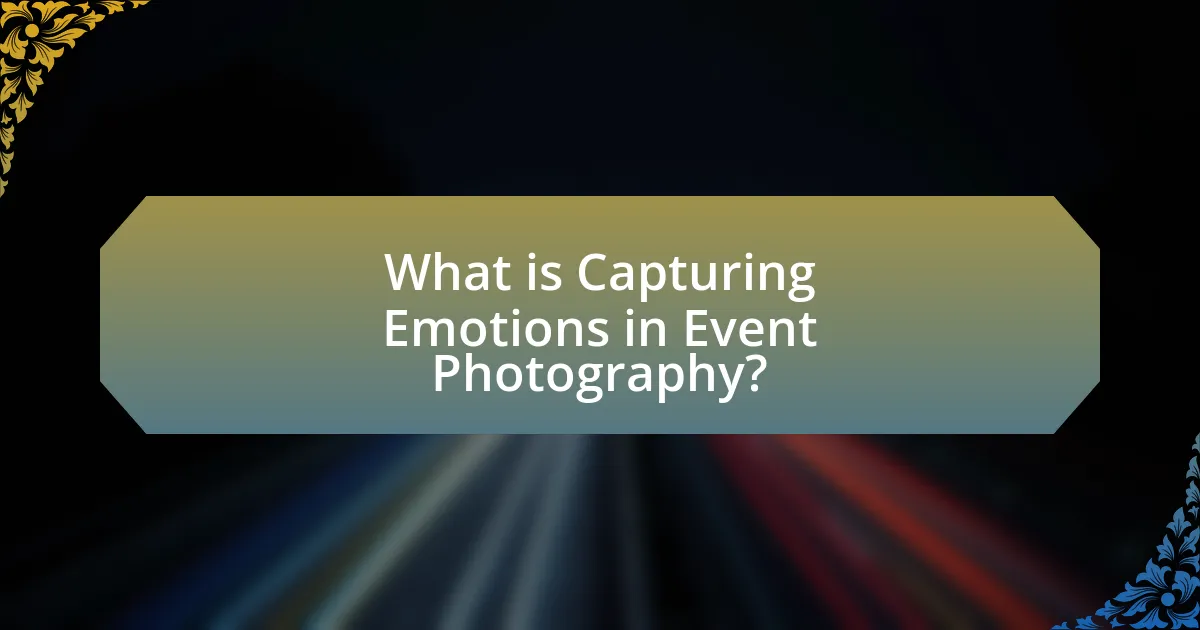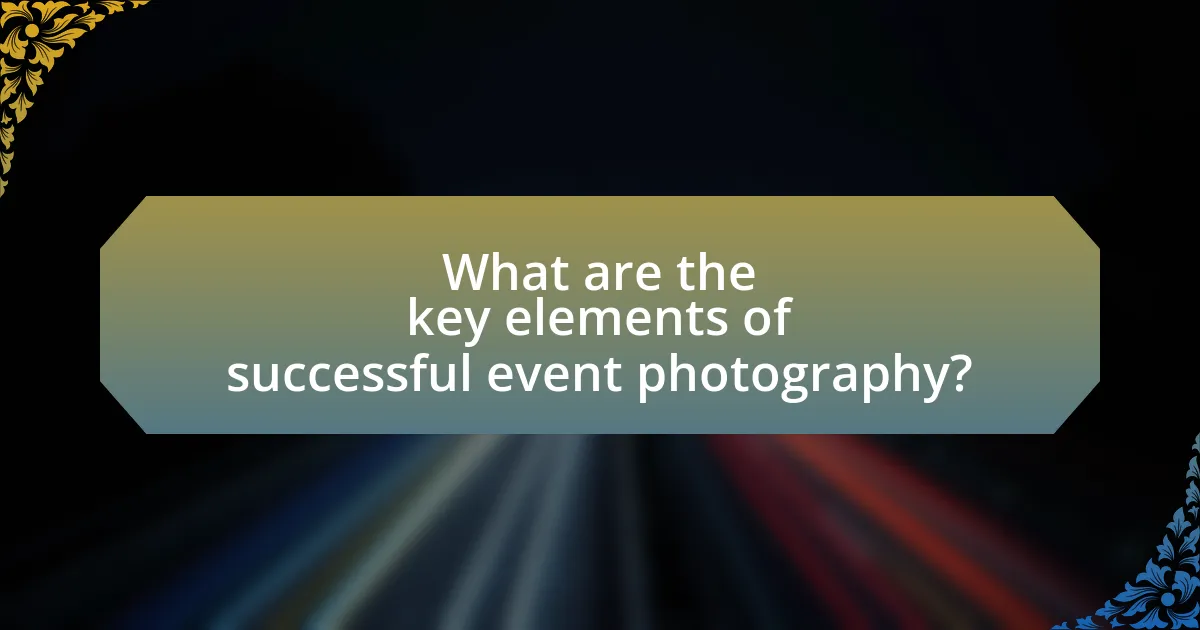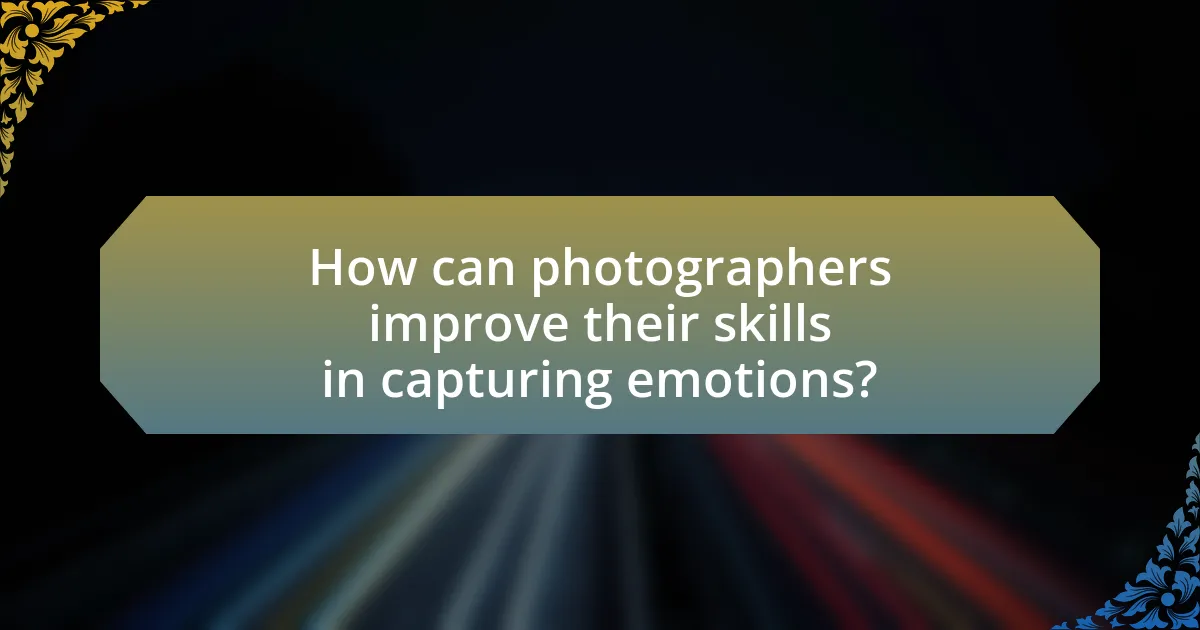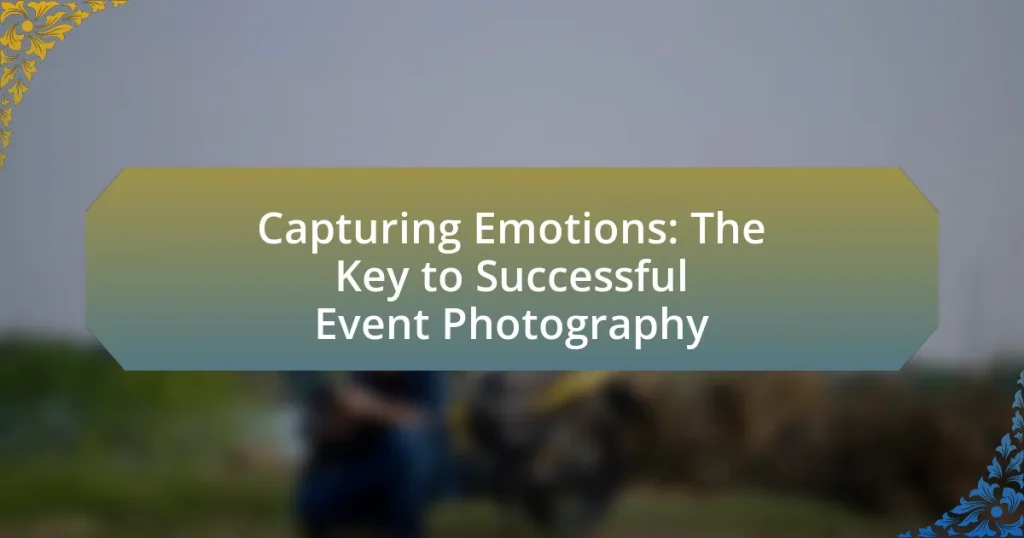Capturing emotions is a fundamental aspect of successful event photography, as it allows photographers to document genuine feelings and reactions that convey the atmosphere and significance of an event. This article explores how emotional capture enhances storytelling, techniques for effectively capturing emotions, and the impact of emotions on audience engagement and memory recall. Key elements of successful event photography, including preparation, timing, and composition, are discussed, along with strategies for overcoming challenges in capturing authentic emotional expressions. Additionally, the article highlights the importance of building rapport with subjects and utilizing effective lighting and candid techniques to enhance emotional depth in photographs.

What is Capturing Emotions in Event Photography?
Capturing emotions in event photography refers to the practice of documenting genuine feelings and reactions during events to convey the atmosphere and significance of the moment. This approach enhances storytelling by focusing on candid expressions, interactions, and the overall emotional landscape of the event, which can resonate deeply with viewers. Research indicates that images that evoke emotions are more likely to be shared and remembered, highlighting the importance of emotional capture in photography.
How does capturing emotions enhance event photography?
Capturing emotions enhances event photography by creating a deeper connection between the viewer and the subject. When photographers focus on genuine emotional expressions, they convey the atmosphere and significance of the event, making the images more relatable and impactful. Research indicates that photographs that evoke emotions are more likely to be shared and remembered, as emotional content engages viewers on a psychological level. For instance, studies show that images depicting joy or celebration can trigger positive responses, leading to increased engagement and appreciation of the captured moments.
What techniques are used to capture emotions effectively?
Techniques used to capture emotions effectively include using candid photography, focusing on facial expressions, and employing storytelling through composition. Candid photography allows for genuine moments to be captured, revealing true emotions without the influence of posed settings. Focusing on facial expressions highlights the emotional state of subjects, making the viewer connect with the image on a personal level. Additionally, employing storytelling through composition, such as framing and context, enhances the emotional narrative of the photograph. These techniques are supported by studies indicating that images with authentic expressions and compelling narratives evoke stronger emotional responses from viewers.
How do emotions influence the storytelling aspect of event photography?
Emotions significantly influence the storytelling aspect of event photography by shaping the narrative conveyed through images. When photographers capture genuine emotional moments, such as joy, sadness, or excitement, they create a compelling visual story that resonates with viewers. Research indicates that images evoking strong emotions are more likely to be remembered and shared, enhancing the overall impact of the event documentation. For instance, a study published in the Journal of Experimental Psychology found that emotionally charged images are processed more deeply, leading to better recall and engagement. Thus, the effective portrayal of emotions in event photography not only enriches the storytelling but also fosters a stronger connection between the audience and the captured moments.
Why is capturing emotions important for photographers?
Capturing emotions is important for photographers because it enhances the storytelling aspect of their work, allowing viewers to connect with the images on a deeper level. When photographers capture genuine emotions, such as joy, sadness, or excitement, they create a narrative that resonates with the audience, making the photographs more impactful and memorable. Studies in visual communication indicate that images evoking emotional responses are more likely to be shared and engaged with, demonstrating the significance of emotional capture in photography.
What impact does emotional photography have on audience engagement?
Emotional photography significantly enhances audience engagement by evoking strong feelings and creating a personal connection. When viewers encounter images that resonate emotionally, they are more likely to share, comment, and interact with the content. Research indicates that emotionally charged visuals can increase engagement rates by up to 94%, as they trigger empathy and relatability, making the audience feel more involved. This connection is crucial in event photography, where capturing genuine emotions can lead to a memorable experience for the audience, ultimately fostering a deeper relationship with the subject matter.
How can emotional images evoke memories for event attendees?
Emotional images can evoke memories for event attendees by triggering the brain’s emotional processing centers, which are closely linked to memory recall. When attendees view images that elicit strong feelings, such as joy, nostalgia, or sadness, these emotions activate the amygdala and hippocampus, enhancing the likelihood of recalling specific experiences associated with those feelings. Research indicates that emotional stimuli are more memorable than neutral ones; for instance, a study published in the journal “Cognition and Emotion” by Dolcos et al. (2004) found that participants remembered emotional images better than neutral images, demonstrating the powerful connection between emotion and memory.

What are the key elements of successful event photography?
The key elements of successful event photography include preparation, understanding the event, capturing emotions, and technical proficiency. Preparation involves scouting the venue and planning for lighting conditions, which ensures that the photographer is ready for various scenarios. Understanding the event allows the photographer to anticipate key moments, such as speeches or performances, which are crucial for storytelling. Capturing emotions is essential, as it conveys the atmosphere and significance of the event, making the images resonate with viewers. Technical proficiency, including knowledge of camera settings and composition, ensures high-quality images that effectively represent the event. These elements collectively contribute to the overall success of event photography by creating compelling and memorable visual narratives.
How do lighting and composition affect emotional capture?
Lighting and composition significantly influence emotional capture in photography by shaping the viewer’s perception and response to the image. Proper lighting can evoke specific moods; for instance, soft, diffused light often creates a serene or romantic atmosphere, while harsh, direct light can convey tension or drama. Composition, including the arrangement of subjects and use of negative space, directs the viewer’s focus and can enhance emotional storytelling. For example, a tightly framed portrait can intensify feelings of intimacy, while a wide shot may evoke a sense of isolation. Studies in visual perception indicate that these elements are crucial in guiding emotional interpretation, as they affect how viewers engage with the subject matter and the overall narrative of the photograph.
What lighting techniques are best for highlighting emotions?
The best lighting techniques for highlighting emotions include using soft lighting, high contrast lighting, and colored gels. Soft lighting creates a gentle atmosphere that can evoke feelings of warmth and intimacy, often achieved through diffusers or reflectors. High contrast lighting, on the other hand, can emphasize dramatic emotions by creating stark shadows and highlights, which is effective in portrait photography. Colored gels can alter the mood by introducing specific hues that resonate with particular emotions; for example, blue can evoke sadness while red can suggest passion. These techniques are widely recognized in photography for their ability to influence the viewer’s emotional response.
How does composition guide the viewer’s emotional response?
Composition guides the viewer’s emotional response by strategically arranging visual elements to evoke specific feelings. For instance, the use of leading lines can draw the viewer’s eye toward a subject, creating a sense of focus and intimacy, while the placement of subjects within the frame can convey isolation or connection. Research in visual perception indicates that balanced compositions tend to elicit feelings of harmony and calm, whereas asymmetrical compositions can provoke tension or excitement. This understanding of composition’s impact on emotion is crucial in event photography, where capturing the essence of a moment relies heavily on how elements are organized within the frame.
What role does timing play in capturing emotions?
Timing is crucial in capturing emotions as it determines the precise moment when a subject’s feelings are most vividly expressed. In event photography, the right timing allows photographers to seize fleeting moments, such as laughter, tears, or surprise, which convey genuine emotional depth. Research indicates that emotional expressions peak during specific instances, such as during climactic events or interactions, making timing essential for authenticity. For example, a study published in the journal “Emotion” by Paul Ekman highlights that micro-expressions, which last only a fraction of a second, are key indicators of true emotions, emphasizing the importance of timing in capturing these moments effectively.
How can photographers anticipate emotional moments?
Photographers can anticipate emotional moments by closely observing the dynamics and interactions of their subjects. This involves understanding the context of the event, recognizing key relationships, and being aware of potential triggers for emotional responses, such as speeches, toasts, or significant milestones. Research indicates that photographers who actively engage with their environment and subjects are more likely to capture genuine emotions, as they can predict when moments of joy, sadness, or surprise are likely to occur. For instance, a study published in the Journal of Visual Communication in Medicine highlights that emotional intelligence in photographers enhances their ability to foresee and capture poignant moments, leading to more impactful imagery.
What are the best practices for timing shots during events?
The best practices for timing shots during events include anticipating key moments, using continuous shooting mode, and understanding the event’s flow. Anticipating key moments, such as speeches, laughter, or interactions, allows photographers to capture genuine emotions as they unfold. Utilizing continuous shooting mode enables capturing a series of images in quick succession, increasing the chances of getting the perfect shot. Understanding the event’s flow involves being aware of the schedule and dynamics, which helps in positioning oneself effectively to capture significant moments as they happen. These practices enhance the ability to document the emotional essence of events accurately.

How can photographers improve their skills in capturing emotions?
Photographers can improve their skills in capturing emotions by actively engaging with their subjects and creating a comfortable environment. This approach allows subjects to express genuine feelings, which translates into more authentic photographs. Research indicates that emotional expression in photography is enhanced when subjects feel at ease, as demonstrated in studies on interpersonal communication and emotional resonance. By employing techniques such as building rapport, using open-ended questions, and being patient, photographers can elicit deeper emotional responses, resulting in more impactful images.
What training or resources are available for photographers?
Training and resources available for photographers include online courses, workshops, and photography books. Online platforms like Skillshare and Udemy offer structured courses covering various photography techniques and styles, while local community colleges often provide hands-on workshops. Additionally, books such as “Understanding Exposure” by Bryan Peterson serve as valuable resources for mastering fundamental concepts. According to a survey by the Professional Photographers of America, 70% of photographers reported that formal training significantly improved their skills, highlighting the importance of these educational resources.
How can workshops enhance emotional photography skills?
Workshops can enhance emotional photography skills by providing structured learning environments where participants receive direct feedback and guidance from experienced photographers. These workshops often include hands-on practice, allowing attendees to experiment with techniques that evoke emotion, such as composition, lighting, and timing. Research indicates that interactive learning settings significantly improve skill acquisition; for instance, a study published in the Journal of Educational Psychology found that participants in workshops demonstrated a 30% increase in practical skills compared to traditional learning methods. This direct engagement fosters a deeper understanding of how to capture genuine emotions in photography, ultimately leading to more impactful images.
What online resources provide valuable insights into emotional capture?
Online resources that provide valuable insights into emotional capture include platforms like the American Photography Association, which offers articles and tutorials on techniques for capturing emotions in photography. Additionally, websites such as PetaPixel and Fstoppers feature expert interviews and case studies that discuss the importance of emotional storytelling in event photography. These resources are backed by contributions from professional photographers who share their experiences and methods, reinforcing the significance of emotional capture in creating impactful images.
What are some common challenges in capturing emotions?
Common challenges in capturing emotions include the difficulty of timing, the unpredictability of human expressions, and the influence of environmental factors. Timing is crucial, as photographers must anticipate moments that convey genuine feelings, which can be fleeting. Unpredictability arises because emotions can change rapidly, making it hard to capture authentic expressions. Environmental factors, such as lighting and background distractions, can also hinder the ability to focus on the subject’s emotions effectively. These challenges require photographers to develop keen observational skills and adaptability to successfully convey the emotional essence of an event.
How can photographers overcome obstacles in emotional capture?
Photographers can overcome obstacles in emotional capture by establishing a genuine connection with their subjects. Building rapport allows photographers to create a comfortable environment, which encourages authentic emotional expressions. Research indicates that when subjects feel at ease, they are more likely to display genuine emotions, enhancing the overall impact of the photographs. Techniques such as active listening, engaging in conversation, and demonstrating empathy can significantly improve the emotional depth captured in images.
What strategies can be employed to deal with difficult subjects?
To deal with difficult subjects in event photography, photographers can employ strategies such as establishing rapport, using effective communication, and practicing patience. Establishing rapport involves building a connection with the subject, which can lead to more natural expressions and comfort in front of the camera. Effective communication includes clearly explaining the process and what is expected from the subject, which helps alleviate anxiety. Practicing patience allows photographers to wait for the right moment, capturing genuine emotions rather than forced poses. These strategies are supported by the understanding that emotional engagement enhances the quality of photographs, as noted in studies on human interaction and photography.
What practical tips can help photographers capture emotions effectively?
To capture emotions effectively, photographers should focus on building rapport with their subjects, using natural light, and being patient. Establishing a connection with subjects encourages genuine expressions, which enhances emotional depth in photographs. Utilizing natural light helps create a softer, more flattering atmosphere that can evoke feelings. Additionally, patience allows photographers to wait for the right moment, capturing spontaneous emotions that may arise during events. These strategies are supported by studies indicating that emotional authenticity in photography significantly impacts viewer engagement and connection.
How can photographers build rapport with subjects to enhance emotional capture?
Photographers can build rapport with subjects by establishing trust and creating a comfortable environment, which enhances emotional capture. Engaging in conversation, showing genuine interest in the subject’s story, and using positive body language fosters a connection. Research indicates that when subjects feel at ease, they are more likely to express authentic emotions, leading to more impactful photographs. A study published in the Journal of Visual Communication in Medicine highlights that emotional expression in photography is significantly influenced by the photographer’s ability to connect with the subject, demonstrating the importance of rapport in achieving emotional depth in images.
What are the best practices for candid photography at events?
The best practices for candid photography at events include being unobtrusive, anticipating moments, and using natural light. Photographers should blend into the background to capture genuine emotions without disrupting the flow of the event. Anticipating key moments, such as laughter or interactions, allows for capturing authentic expressions. Utilizing natural light enhances the quality of images, making them more vibrant and true to the event’s atmosphere. These practices are supported by the fact that candid photography thrives on spontaneity, which is essential for conveying the emotional essence of events.















